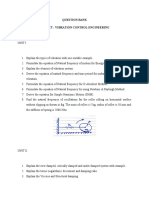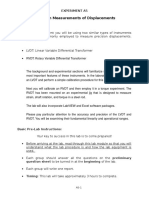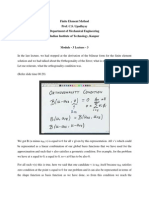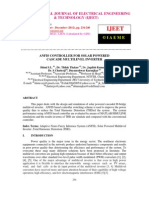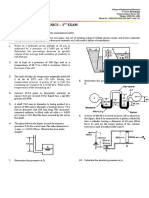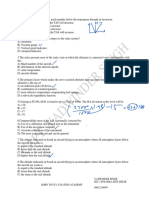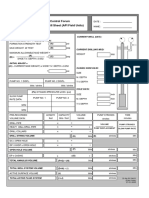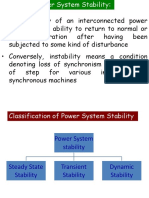Professional Documents
Culture Documents
ENT 286 Instrumentation & Measurement: Measurement of Solid Mechanical Quantities
ENT 286 Instrumentation & Measurement: Measurement of Solid Mechanical Quantities
Uploaded by
yccy1223Original Description:
Original Title
Copyright
Available Formats
Share this document
Did you find this document useful?
Is this content inappropriate?
Report this DocumentCopyright:
Available Formats
ENT 286 Instrumentation & Measurement: Measurement of Solid Mechanical Quantities
ENT 286 Instrumentation & Measurement: Measurement of Solid Mechanical Quantities
Uploaded by
yccy1223Copyright:
Available Formats
ENT 286 Instrumentation &
Measurement
Measurement of Solid Mechanical
Quantities
Measuring Strain
When a force is applied to a structure, the
components of the structure change slightly
in their dimensions and are said to be
strained
Devices to measure these small changes in
dimensions are called strain gages
Electrical Resistance Strain Gage
When a supported beam is bent by applying is
bent by applying a lateral force, the beam will
become longer on the bottom surface and
shorter on the top surface
When beam is loaded, wire is stretched and its
length becomes
The ration is known as strain
l l o +
l l / o
A simple strain gage
Electrical Resistance Strain Gage
It is often to determine the stresses in a
structure experimentally to demonstrate that
the structure is sound
For elastic materials stressed in a single
direction, the stain is
c o E =
Electrical Resistance Strain Gage
The resistance of a wire is
Strain Gage Factor
A
L
R
=
a
pL d
v S
c
/
2 1 + + =
Foil Strain Gage
Strain Gage Signal Conditioning
To measure strain with a bonded resistance
strain gage, strain gage must be connected to
an electric circuit that is capable of
measuring the minute changes in resistance
corresponding to strain.
We need a device that will measure the
change in resistance rather than the
resistance itself.
Wheatstone Bridge
A simple circuit performs this function is
called Wheatstone Bridge.
Wheatstone Bridge
Strain Gage Signal Conditioning
If all four resistors have same value, the voltage at points
B and D must be the same, therefore Vo must be zero.
(bridge is balanced)
The bridge is considered balanced when R1/R4 = R2/R3
and, therefore, Vo equals zero.
When strain gage is strained, R3 changes from its initial
value, bridge becomes unbalanced and Vo will changed.
Any small change in the resistance of the sensing grid will
put the bridge out of balance, making it suitable for the
detection of strain.
Strain Gage Signal Conditioning
When the bridge is set up so that R3 is the
only active strain gage, a small change in R3
will result in an output voltage from the
bridge
The bridge is allowed to become unbalanced
and the output voltage can be used to
determine the gage resistance.
Strain Gage Signal Conditioning
Using Ohms Law, current flows through
branches ABC and ADC are
4 1
R R
V
I
s
ABC
+
=
3 2
R R
V
I
s
ADC
+
=
Strain Gage Signal Conditioning
Voltage drop across R4, VB-VC is IABCR4
Voltage drop across R3, VD-VC is IADCR3
Then Vo =VD-VB
4 1
4
3 2
3
R R
V R
R R
V R
V
s s
o
+
+
=
) )( ( ) )( (
4 1 3 2
2 4 1 3
4 1 3 2
4 3 2 4 4 3 1 3
R R R R
R R R R
V
R R R R
R R R R R R R R
V V
s s o
+ +
=
+ +
+
=
Strain Gage Signal Conditioning
Before strain is applied, the initial resistance
of the strain gage is R3i.
For the bridge to be initially balance,
When the strain gage is strained, we set
0
2 4 1 3
= R R R R
i
3 3 3
R R R
i
A + =
Strain Gage Signal Conditioning
Then Vo is
Equation relating the strain to the output voltage
(quarter-bridge):
Higher order bridge:
) )( (
4 1 3 3 2
3 1
R R R R R
R R V
V
i
s
o
+ A + +
A
=
i s
i o
a
R SR V
R R V
3 2
2
3 2
) ( +
= c
2 3 3 1 2 4
2
2 3 3 1 2 4
( )
s
o
V R R R R R R
V
R R R R R R
| |
A A A A
= +
|
+
\ .
Exercises
Measuring Displacement
Potentiometer
Linear potentiometer is a device which
resistance varies as a function of the potion
of a slider
With the supply voltage, the output voltage
will vary between zero and the supply
voltage.
Linear Potentiometer
http://www.instrumentationtoday.com/lin
ear-potentiometer-transducer/2011/07/
Linear Potentiometer
For linear potentiometer, the output is a
simple linear function of the slider position.
Linear potentiometer can be used to measure
displacements as small as 0.1 to 0.2 in. up to
displacement of more than 1 ft.
s o
V
L
x
V =
Angular Potentiometer
Angular Potentiometer
Angular Potentiometer can be designed to
measure angular displacement of 3500
o
.
Potentiometer
Potentiometers are quite inexpensive, are
readily available and require no special signal
conditioning
Linear and Rotary Variable
Differential Transformers
Measure displacement by modifying the
spatial distribution of an alternating
magnetic field.
Measure displacements directly
Linear Variable Differential
Transformer (LVDT)
Linear Variable Differential
Transformer (LVDT)
LVDT has a single primary coil and two
secondary coils.
An oscillating excitation voltage (50 Hz and
25 kHz is applied to the primary coil.
Current flowing through the primary coil
creates an alternating magnetic field, which
induces alternating voltage in coils B and C.
Linear Variable Differential
Transformer (LVDT)
The core, made of ferromagnetic material,
tend to concentrate the magnetic field in its
vicinity
If it is closer to one of the secondary coils,
the voltage in the coil will be higher
Linear Variable Differential
Transformer (LVDT)
Voltage generated in
coil C will be higher
than that generated in
coil B since the core is
displaced downward.
Linear Variable Differential
Transformer (LVDT)
The two voltages from coils B and C oppose each
other.
If the core is centered between the two
secondary coils and the voltages in coils B and C
are the same, the net output voltage V
2
will be
zero (or minimum).
If core the core is not centered there will be a
net output voltage.
Linear Variable Differential
Transformer (LVDT)
LVDT sensor output.
Linear Variable Differential
Transformer (LVDT)
LVDT cross section.
Linear Variable Differential
Transformer (LVDT)
Both primary and secondary coils are
wrapped around a hollow, nonmagnetic
bobbin, and the core slides inside the bobbin.
Output voltage versus time for LVDT: (a)
core displaced upward from center; (b)
core displaced down from center.
By sensing the phase of the output
voltage relative to the primary voltage,
the signal conditioner can determine
the direction of the core displacement.
Linear Variable Differential
Transformer (LVDT)
http://www.rdpe.com/displacement/lvdt/lvdt-principles.htm
Rotary Variable Differential
Transformer
Rotary variable differential transformer: (a) schematic; (b) simplified
construction. [(b) Based on Herceg, 1976.]
Capacitive Displacement Sensor
Most appropriate for measuring very small
displacements (0.00001 to 0.01 in.)
The capacitance of a capacitor is s function of
the distance between the plates and the area
of the plates
d
A
K C
0
e =
Capacitive Displacement Sensor
There are two ways of using capacitive
transducer for displacement measurements.
Capacitive Displacement Sensor
One plate is moved so that
distance d between the plates
varies
The capacitance is a nonlinear
function of the displacement
Capacitive Displacement Sensor
One of the plate can be
moved parallel to the
other plate so that the
overlapping area varies
The capacitance is
approximately a linear
function of the
displacement
Capacitive Displacement Sensor
Since the output of the capacitive sensor is
not a voltage, signal conditioning is required.
Wheatstone bridge for capacitance
measurement.
Examples
Measuring Linear Velocity
Doppler Radar Velocity Measurement
If a beam of radio waves is directed at a
moving object, the frequency of radiation
reflected from object will be altered
Doppler Radar Velocity Measurement
The change in frequency of radiation directed
at the moving object is given by:
u cos 2V
f
D
=
Velocity Determination Using
Displacement and Acceleration
Sensors
Displacement and acceleration transducers provide data that
can be used to determine velocity.
If displacement data are available in the form of x(t), the
velocity can be obtained by differentiating these data:
dt
t dx
V
) (
=
Velocity Determination Using
Displacement and Acceleration
Sensors
If acceleration data are available in the form
a(t), by integration the velocity can be
estimated as
}
+ =
t
t
dt t a V t V
0
) ( ) (
0
Examples
Measuring Angular Velocity
Electric Generator Tachometers
Small DC electric generator is attached to shaft end.
Output of generator is a voltage of the function of shaft
angular velocity
Magnetic Pickup
Uses the principle of emf
distortion.
Pulse counter is used to
calibrated with angular
velocity
Stroboscopic Tachometer
Photoelectric Tachometer
Measuring Acceleration and Vibration
Piezoelectric Accelerometers
Piezoelectric Sensing Element
Quartz crystal
When deformed, capable of generating an
electric charge
Piezoelectric Accelerometers
Piezoelectric sensors: (a) longitudinal effect; (b) transverse effect.
Piezoelectric Accelerometers
When the load is applied, electrons move to
one of the conducting surfaces and away
from the other
Results in charge being stored by the
inherent capacitance of the piezoelectric
material itself.
Piezoelectric Accelerometers
For the arrangement of longitudinal effect,
charge generated is
For transverse effect, the charge generated is
d F Q =
a
b
d F Q =
Piezoelectric Accelerometers
If ratio of the dimension, b/a is greater than
1, the transverse effect will produce a greater
charge than the longitudinal effect.
With either loading, the charge is
proportional to the applied force
The charge will result in voltage.
Piezoelectric Accelerometers
Accelerometer Using Piezoelectric Sensing
Elements
Piezoelectric Accelerometers
Consist of housing, a mass (seismic mass) and a
piezoelectric sensing element.
An initial force between the mass and the sensor is
obtained with a preloading spring sleeve.
As the housing of the accelerometer is subject to an
acceleration, the force exerted by the mass on the
quartz crystal is altered.
This generates a charge on the crystal
Measuring Force
Load Cells
Virtually any simple metal structure will deform when
subjected to a force
As long as the resulting stresses are below the material yield
stress, the deflection () and resulting strain () will be linear
functions of the applied force:
o
1
C F =
c
2
C F =
Load Cells
Common types of load cells: (a) cantilever beam; (b) hollow cylinder.
Load Cells
A cantilevered beam instrumented with four strain gages
Two on the top and two on the bottom
Load Cells
The hollow cylinder load cell also uses
four strain gages and is also temperature
compensated.
As the cylinder is compressed, it not only
becomes slightly shorter but also
become slightly larger in diameter
Two of the gages measure the axial
compression
Other two are mounted transversely and
measure the tensile diametral strain
References
http://www.omega.com/literature/transacti
ons/volume3/strain2.html
http://www.rdpe.com/displacement/lvdt/lv
dt-principles.htm
You might also like
- 1101 10 Iit-GeniusDocument33 pages1101 10 Iit-GeniusArnav Hadatgune67% (3)
- 1.3 General Input Output ConfigurationDocument5 pages1.3 General Input Output ConfigurationvanithaNo ratings yet
- IS 2309 Vs IS - IEC 62305Document15 pagesIS 2309 Vs IS - IEC 62305sangeetarai100% (3)
- Stress, Strain, and Strain GagesDocument6 pagesStress, Strain, and Strain GagesKavitha KaviNo ratings yet
- Stress, Strain, and Strain Gages PrimerDocument11 pagesStress, Strain, and Strain Gages PrimerherbertmgNo ratings yet
- Numerical Methods - An IntroductionDocument30 pagesNumerical Methods - An IntroductionPrisma FebrianaNo ratings yet
- Application of Agro-Waste For Sustainable Construction Materials - A ReviewDocument7 pagesApplication of Agro-Waste For Sustainable Construction Materials - A ReviewNaseeruddin Haris Naseeruddin HarisNo ratings yet
- Laboratory Manual - P1Document10 pagesLaboratory Manual - P1Bhushan RaisinghaniNo ratings yet
- Exparimental Design MatrixDocument38 pagesExparimental Design MatrixGurpreet SandhuNo ratings yet
- Rheology of ConcreteDocument21 pagesRheology of ConcreteSanchit GuptaNo ratings yet
- MHDDocument33 pagesMHDkashyapNo ratings yet
- Design and Construction of Earth Fault Relay For Single Phase SystemDocument3 pagesDesign and Construction of Earth Fault Relay For Single Phase SystemGururaj BandaNo ratings yet
- Tidal Energy and It's Prospects (Final - 4M - BD)Document55 pagesTidal Energy and It's Prospects (Final - 4M - BD)Masudur RahmanNo ratings yet
- Introduction To Design of Experiments: by Michael MonteroDocument25 pagesIntroduction To Design of Experiments: by Michael Monteroducnguyenso100% (1)
- Wireless Power Theft Monitoring SystemDocument3 pagesWireless Power Theft Monitoring SystemVIVA-TECH IJRINo ratings yet
- Wipro R & DDocument17 pagesWipro R & DDhanyaNo ratings yet
- Mechanical Engineering - Course CurriculumDocument539 pagesMechanical Engineering - Course CurriculumwnaickerNo ratings yet
- Float Zone & Bridgman Crystal Growth Techniques: Abu Syed Md. Jannatul Islam Lecturer, Dept. of EEE, KUET, BDDocument27 pagesFloat Zone & Bridgman Crystal Growth Techniques: Abu Syed Md. Jannatul Islam Lecturer, Dept. of EEE, KUET, BDBomkesh SardarNo ratings yet
- Mechatronics - Unit 5 - NotesDocument13 pagesMechatronics - Unit 5 - NotesDulce DeNo ratings yet
- University Institute of Engineering Department Au-1Document40 pagesUniversity Institute of Engineering Department Au-1Manveer SinghNo ratings yet
- MJR ppt-1Document15 pagesMJR ppt-1teslaNo ratings yet
- Solar Energy and ApplicationsDocument20 pagesSolar Energy and ApplicationsSanath ReddyNo ratings yet
- Question Bank Subject: Vibration Control EngineeringDocument5 pagesQuestion Bank Subject: Vibration Control EngineeringOmNo ratings yet
- Measurement and Instrumentation AnalysisDocument13 pagesMeasurement and Instrumentation AnalysisYinka Ajinaja0% (1)
- A5 EXPERIMENT LVDT and RVDTDocument14 pagesA5 EXPERIMENT LVDT and RVDTDuminduJayakodyNo ratings yet
- Timarpur Okhla Integrated BOOTDocument23 pagesTimarpur Okhla Integrated BOOTArun KumarNo ratings yet
- Project 12Document44 pagesProject 12harsha9ramireddyNo ratings yet
- DC GeneratorDocument38 pagesDC GeneratorAshwini ChaurasiaNo ratings yet
- Chapter 1 Briefing IntroductionDocument101 pagesChapter 1 Briefing IntroductionAhmed AsnagNo ratings yet
- Nanolithography - Processing Methods PDFDocument10 pagesNanolithography - Processing Methods PDFNilesh BhardwajNo ratings yet
- Photo Transistor 1Document5 pagesPhoto Transistor 1kriitkaNo ratings yet
- Ch-7-Similitude, Dimensional Analysis & ModelingDocument40 pagesCh-7-Similitude, Dimensional Analysis & ModelingImran AhmedNo ratings yet
- Mathematical Model of The PMSG Based On Wind Energy Conversion SystemDocument7 pagesMathematical Model of The PMSG Based On Wind Energy Conversion SystemIRJIENo ratings yet
- Fuel CellDocument51 pagesFuel CellAbrar MominNo ratings yet
- Transformers PDFDocument30 pagesTransformers PDFMichael Williams100% (1)
- Power Supply SystemDocument49 pagesPower Supply SystemstephenNo ratings yet
- EE6503 Power Electronics NotesDocument234 pagesEE6503 Power Electronics Notessyed ibrahimNo ratings yet
- Components For Embedded ProgramsDocument16 pagesComponents For Embedded ProgramsRajesh cNo ratings yet
- An Overview On Application of Nanotechnology in Construction IndustryDocument5 pagesAn Overview On Application of Nanotechnology in Construction IndustryNel HenaoNo ratings yet
- Conventional and Non Conventional Energy Sourse Unit 3Document48 pagesConventional and Non Conventional Energy Sourse Unit 3Muruganandham JNo ratings yet
- Finite Element Method Prof. C.S. Upadhyay Department of Mechanical Engineering Indian Institute of Technology, KanpurDocument27 pagesFinite Element Method Prof. C.S. Upadhyay Department of Mechanical Engineering Indian Institute of Technology, KanpurabimanaNo ratings yet
- Nanotechnology in Civil EngineeringDocument22 pagesNanotechnology in Civil EngineeringNehad AhmedNo ratings yet
- Unit 3 STABILIZATION - OF - SOILS - USING - GEOSYNTHETICS PDFDocument8 pagesUnit 3 STABILIZATION - OF - SOILS - USING - GEOSYNTHETICS PDFDept. of Civil EngineeringNo ratings yet
- EE8072-MEMS and Nano ScienceDocument10 pagesEE8072-MEMS and Nano ScienceMs.Ezhilarasi ICE DepartmentNo ratings yet
- Tidal EnergyDocument20 pagesTidal Energynirmala M.S.No ratings yet
- Solar CellDocument33 pagesSolar CellSumit BansalNo ratings yet
- Anfis Controller For Solar Powered Cascade Multilevel InverterDocument7 pagesAnfis Controller For Solar Powered Cascade Multilevel InverterIAEME PublicationNo ratings yet
- Ee3301 Emf QPDocument4 pagesEe3301 Emf QPKeerthana SahadevanNo ratings yet
- Lab Manual - BWPDocument23 pagesLab Manual - BWPAneesh KumarNo ratings yet
- Electric Power Transmission Is The Bulk Transfer ofDocument3 pagesElectric Power Transmission Is The Bulk Transfer ofKarteekNo ratings yet
- Health Monitoring of Pavement Systems Using Smart Sensing TechnolDocument198 pagesHealth Monitoring of Pavement Systems Using Smart Sensing TechnolPeteris Skels100% (1)
- Isoloop Magnetic CouplerDocument26 pagesIsoloop Magnetic CouplerVarun Pathak100% (8)
- A Project Report On Sizing and Costing of PVDocument4 pagesA Project Report On Sizing and Costing of PVpatrickNo ratings yet
- EE GATE 2017 Afternoon 1Document46 pagesEE GATE 2017 Afternoon 1Anonymous gUjimJKNo ratings yet
- Sensors: A Survey On Gas Sensing TechnologyDocument31 pagesSensors: A Survey On Gas Sensing TechnologyGerald KhoNo ratings yet
- V S DDocument17 pagesV S DveguruprasadNo ratings yet
- Strain Gauge LectureDocument48 pagesStrain Gauge LectureSridhar Kanagaraj100% (1)
- Ijamss - Review Paper On The Runge-Kutta Methods To Study Numerical Solutions of Initial Value Problems in Ordinary Differential EquationsDocument10 pagesIjamss - Review Paper On The Runge-Kutta Methods To Study Numerical Solutions of Initial Value Problems in Ordinary Differential Equationsiaset123No ratings yet
- Fractional Factorial Design of Experiment: Che 143 Undergraduate Chemical Engineering Research 1Document22 pagesFractional Factorial Design of Experiment: Che 143 Undergraduate Chemical Engineering Research 1tommxDNo ratings yet
- Sankar Polytechnic College (Autonomous) Sankar Nagar: by S.Dilip Kumar LecturerDocument48 pagesSankar Polytechnic College (Autonomous) Sankar Nagar: by S.Dilip Kumar LecturerDilipkumarSureshNo ratings yet
- Unit 2 Overview of Sensors, Transducers and Their Characteristics SpecificationsDocument87 pagesUnit 2 Overview of Sensors, Transducers and Their Characteristics SpecificationsSahilNo ratings yet
- PHASE FAULT OVER CURRENT RELAY SETTING (WRKNG)Document35 pagesPHASE FAULT OVER CURRENT RELAY SETTING (WRKNG)Madhu DuraichamyNo ratings yet
- Ce 343L - Fluid Mechanics - 1 ExamDocument2 pagesCe 343L - Fluid Mechanics - 1 ExamMichelle Daarol100% (1)
- Load Bank LP400-240-480-5MTDocument1 pageLoad Bank LP400-240-480-5MTCarlos U. CallirgosNo ratings yet
- Wind Energy Fundamentals LeseprobeDocument58 pagesWind Energy Fundamentals LeseprobeIqbal MeskinzadaNo ratings yet
- Automatic Power Factor CompensationDocument5 pagesAutomatic Power Factor CompensationIJARSCT JournalNo ratings yet
- Compilation Crkts 3Document9 pagesCompilation Crkts 3Rainier RamosNo ratings yet
- Service Manual M1913NDocument22 pagesService Manual M1913NMICRO MAX TELECOMUNICACIONESNo ratings yet
- Physics: Paper 1Document28 pagesPhysics: Paper 1Nowshin NamiraNo ratings yet
- R2S R2D-1709994Document5 pagesR2S R2D-1709994Jorge CotzomiNo ratings yet
- Class 9th NBF 2022 (CH 1 2 3 4 5 6 7) Conceptual QuestionsDocument65 pagesClass 9th NBF 2022 (CH 1 2 3 4 5 6 7) Conceptual QuestionsQasim Humdani100% (5)
- Sofcon India Pvt. LTD., Lucknow: Vocational Training IN Panel Designing ,& Variable Speed DrivesDocument22 pagesSofcon India Pvt. LTD., Lucknow: Vocational Training IN Panel Designing ,& Variable Speed Drivesshailendra89No ratings yet
- Electric Kalsual MawDocument3 pagesElectric Kalsual MawJoel GuiteNo ratings yet
- BWIM ManualDocument181 pagesBWIM ManualDavid Jr NelliasNo ratings yet
- Projectile Launched at An AngleDocument47 pagesProjectile Launched at An AngleAiza Cabatingan100% (1)
- Pe 323Document42 pagesPe 323Farhan SafdarNo ratings yet
- 2015 O-Level Physics Paper 2 Answer by Calvin Kong PhysicsDocument6 pages2015 O-Level Physics Paper 2 Answer by Calvin Kong PhysicsjesudassajNo ratings yet
- Electronvolt - WikipediaDocument1 pageElectronvolt - WikipediaBraian De LeonNo ratings yet
- Price Tag Guide For Insulatorsqqrpw PDFDocument6 pagesPrice Tag Guide For Insulatorsqqrpw PDFshellelbow42No ratings yet
- Instrument Nav Test SolvedDocument16 pagesInstrument Nav Test SolvedPunyaaNo ratings yet
- Manual 1vdc400155Document7 pagesManual 1vdc400155Matheus VenancioNo ratings yet
- Experiment # 1: Time and Frequency Responses of Series RLC CircuitsDocument6 pagesExperiment # 1: Time and Frequency Responses of Series RLC CircuitsJhonn HuamFloNo ratings yet
- Emc Systems Installations 2000 Part 1 EarthingDocument11 pagesEmc Systems Installations 2000 Part 1 EarthingFernando VidalNo ratings yet
- CW Mock 2017Document74 pagesCW Mock 2017Cardry MusicNo ratings yet
- Centrifugal Pumps: Installation and Use Performance RangeDocument4 pagesCentrifugal Pumps: Installation and Use Performance RangeRik StevenNo ratings yet
- 14b-Kill Sheet PreparationDocument10 pages14b-Kill Sheet PreparationLorenaStămulescuNo ratings yet
- Power System StabilityDocument83 pagesPower System StabilitywaelNo ratings yet
- Thermodynamics (JEE - Advanced) - 9th Oct. PDFDocument27 pagesThermodynamics (JEE - Advanced) - 9th Oct. PDFRhythm BansalNo ratings yet
- Enset Ngine: PerformancesDocument2 pagesEnset Ngine: PerformancesCarlos Aguiar0% (1)






















